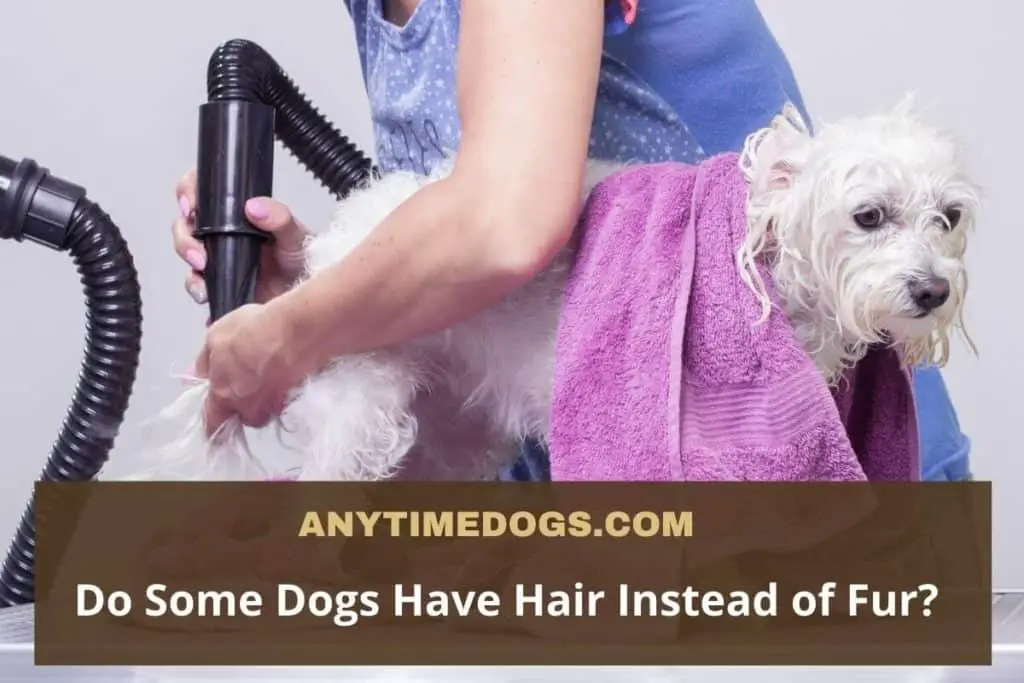Every dog is different. Many characteristics differentiate one dog from another, ranging from breed to size, shape, and personality. However, the coat of a dog is one of the most unique features.
Dogs differ not only in appearance but also in hair or fur. Do you wonder why Do Some Dogs Have Hair Instead of Fur? It might look strange to think of dogs having hair, but many dog breeds have hair instead of fur.
Hair coats can grow to unknown lengths if not trimmed. However, some breeds have less hair or are nearly hairless.
What Is the Difference Between Dog’s Hair or Fur?
Single-coated dogs are known as hairy dogs, while double-coated dogs are known as fur coats. Both fur and hair are made of keratin, a protein found in skin and nails.
In dogs, hair tends to be longer and thicker and grows beyond the length forming a protective layer of warmth and water resistance over the dog.
Whereas, in contrast, fur tends to be short, fine, and tightly packed together and the fur of dogs only grows to a certain length. Because individual hair on dogs with fur reaches the Catagen and subsequent phases sooner.
So, the dogs having furs tend to lose and regrow their hair more frequently. This is why it appears that dogs with fur shed more than dogs with hair.
Which Breeds of Dogs Have Hair Instead of Fur?
According to American Kennel Club, there are at least 36 dog breeds that have hair instead of fur. Let’s take a quick look at dog breeds with hair.
1. Large Breeds of Dogs with Hair:
Large dogs breed having hair includes Standard poodles, Portuguese water dogs, and bearded collies.
2. Medium Breeds of Dogs with Hair:
Miniature poodles, Polish lowland sheepdogs, miniature coated Xolos, Bedlington, Kerry blue, wirehaired fox, Tibetan, and soft coated wheaten are among medium-sized breeds.
3. Small Breeds of Dogs with Hair
Several small and toy breeds have hair as well, including the Bichon Frise, Maltese, Yorkshire terrier, and Shih-Tzu.
Do Dogs Breed with Hair Shed?
Thanks to their hair, dogs with hair shed less than dogs with fur. They don’t have a shedding season, and their hair tends to fall back into their coat. Like humans, dogs’ hair will occasionally fall out but not in large quantities as fur.
How to Take Care of Your Dogs’ Hair?
All dogs require grooming. Hair traps particles and dead follicles more easily than fur. This can be beneficial when it comes to cleaning up your home because dogs with hair do not shed as much.
However, there is a risk that trapped hair will cause knots and matting, which can trap moisture, debris, and parasites closer to the skin, potentially leading to infections or infestations.
Brushing dogs with hair regularly will help to dislodge trapped material and prevent matting.
Bathing can help reduce the number of allergens released during brushing; however, bathing too frequently can cause the dryness in skin.
Finally, it is best to consult your veterinarian or a groomer about your dog’s daily grooming requirements.
Which Breed of Dogs Have Fur?
While all dogs are loveable and need to be admired. But if you want to have a fluffy four-legged friend, you should go for a fur dog. Fur dogs mostly consist of three coats; undercoat, guard hair, and whiskers.
Let us discuss some of the breeds of dogs with furs.
1. Large Fur Dogs:
Large fur dog includes Samoyed, Siberian husky, German shepherd, Great Pyrenees, Saint Bernard.
2. Medium Fur Dogs:
Shetland sheepdogs, American Eskimo, border collie, barbet, and keeshond are some medium-sized fluffy dogs one can have.
3. Small Fur Dogs:
Breeds of dogs that are small in size and contain fur are miniature poodles, Shih Tzus, Maltese, cockapoo, Havanese, and Pomeranian.
Do Dogs with Fur Shed?
The fur on a dog grows in seasonal cycles. It stops growing and falls out when it reaches a genetically determined length. This process is known as shedding. Dogs’ shedding is determined by daily sunlight and the temperature of the environment.
Hair and fur develop in four stages:
1. Anagen:
Anagen is the active growing phase of hair.
2. Catagen:
Catagen is the final stage of hair growth.
3. Telogen:
Telogen is the phase in which your dog’s fully grown hair is both attached and dormant. Telogen is also referred to as the resting phase.
4. Exogen:
The exogen phase is when the hair begins to fall out. After the Exogen phase, the follicle enters the Anagen phase, and new hair begins to grow.
When this happens all at once in the dog’s undercoat. The thick, protective undercoat is the majority of what is shed.
Breeds of dogs having furs “blow their coats” twice a year and they shed too much more as compared to dogs with hair.
How to Take Care of Dogs with Fur?
Fur doesn’t hold as many particles and follicles as hair does. But these substances are spread more easily through shedding, so you will have to spend more time vacuuming and using hair rollers to keep your environment clean.
Although, brushing is necessary for dogs that have fur. It can clean fur particles and collect shedding fur before it spreads throughout your home.
Knots and matting can still occur in dogs with fur, and it is difficult to use a brush that can reach the undercoat of your dog.
What’s Better? Dog with Hair or Fur? Final Thoughts
Dogs with hair are thought to be more hypoallergenic than dogs with fur because they do not appear to shed as much. However, the people who are allergic to dog hair or fur are allergic to the dander that is attached to the hair.
Because dogs with fur shed more frequently, dander is released more frequently as well. hence, it is better to adopt a dog with hair if you do not want to clean up all day every day.

